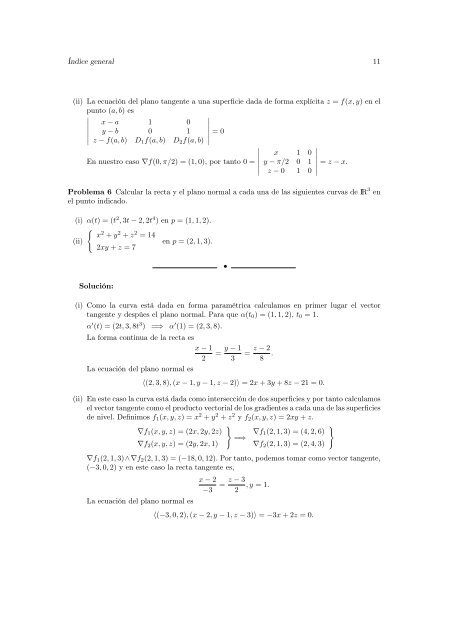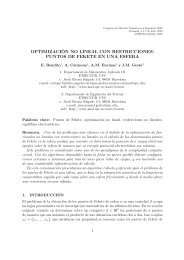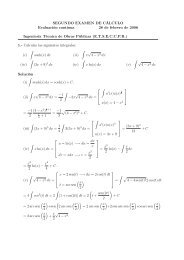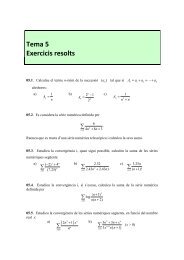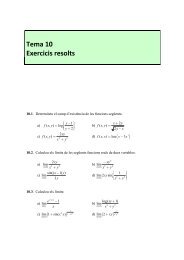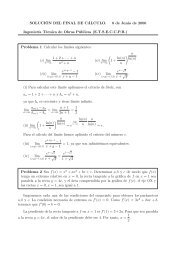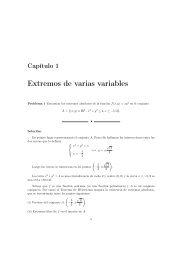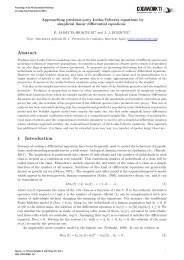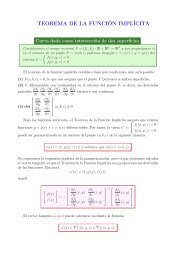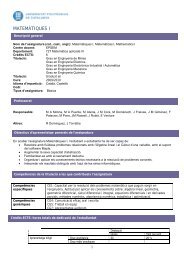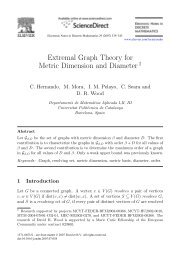Problemas de diferenciabilidad y geométricos
Problemas de diferenciabilidad y geométricos
Problemas de diferenciabilidad y geométricos
You also want an ePaper? Increase the reach of your titles
YUMPU automatically turns print PDFs into web optimized ePapers that Google loves.
Índice general 11<br />
(ii) La ecuación <strong>de</strong>l plano tangente a una superficie dada <strong>de</strong> forma explícita z = f(x, y) en el<br />
punto (a, b) es<br />
x − a 1 0<br />
y − b 0 1<br />
∣ z − f(a, b) D 1 f(a, b) D 2 f(a, b) ∣ = 0<br />
x 1 0<br />
En nuestro caso ∇f(0, π/2) = (1, 0), por tanto 0 =<br />
y − π/2 0 1<br />
∣ z − 0 1 0 ∣ = z − x.<br />
Problema 6 Calcular la recta y el plano normal a cada una <strong>de</strong> las siguientes curvas <strong>de</strong> IR 3 en<br />
el punto indicado.<br />
(i) α(t) = (t 2 , 3t − 2, 2t 4 ) en p = (1, 1, 2).<br />
(ii)<br />
{<br />
x 2 + y 2 + z 2 = 14<br />
2xy + z = 7<br />
en p = (2, 1, 3).<br />
•<br />
Solución:<br />
(i) Como la curva está dada en forma paramétrica calculamos en primer lugar el vector<br />
tangente y <strong>de</strong>spúes el plano normal. Para que α(t 0 ) = (1, 1, 2), t 0 = 1.<br />
α ′ (t) = (2t, 3, 8t 3 ) =⇒ α ′ (1) = (2, 3, 8).<br />
La forma continua <strong>de</strong> la recta es<br />
x − 1<br />
= y − 1 = z − 2<br />
2 3 8 .<br />
La ecuación <strong>de</strong>l plano normal es<br />
〈(2, 3, 8), (x − 1, y − 1, z − 2)〉 = 2x + 3y + 8z − 21 = 0.<br />
(ii) En este caso la curva está dada como intersección <strong>de</strong> dos superficies y por tanto calculamos<br />
el vector tangente como el producto vectorial <strong>de</strong> los gradientes a cada una <strong>de</strong> las superficies<br />
<strong>de</strong> nivel. Definimos f 1 (x, y, z) = x 2 + y 2 + z 2 y f 2 (x, y, z) = 2xy + z.<br />
∇f 1 (x, y, z) = (2x, 2y, 2z)<br />
∇f 2 (x, y, z) = (2y, 2x, 1)<br />
}<br />
=⇒ ∇f 1(2, 1, 3) = (4, 2, 6)<br />
∇f 2 (2, 1, 3) = (2, 4, 3)<br />
∇f 1 (2, 1, 3)∧∇f 2 (2, 1, 3) = (−18, 0, 12). Por tanto, po<strong>de</strong>mos tomar como vector tangente,<br />
(−3, 0, 2) y en este caso la recta tangente es,<br />
La ecuación <strong>de</strong>l plano normal es<br />
x − 2<br />
−3 = z − 3<br />
2 , y = 1.<br />
〈(−3, 0, 2), (x − 2, y − 1, z − 3)〉 = −3x + 2z = 0.<br />
}


